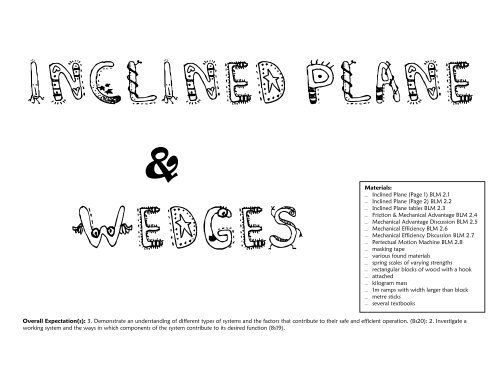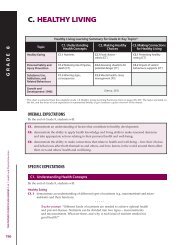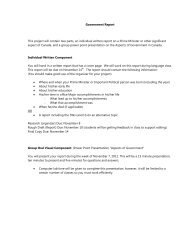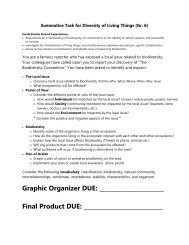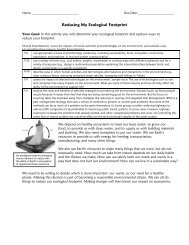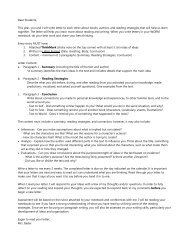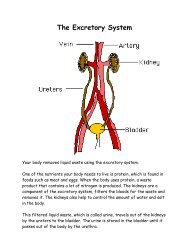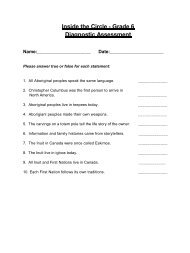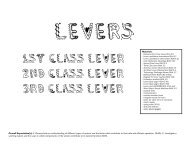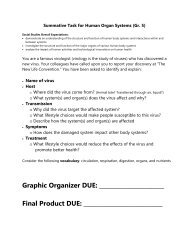Inclined Plane and Wedge - Mrs. Bader's Classroom
Inclined Plane and Wedge - Mrs. Bader's Classroom
Inclined Plane and Wedge - Mrs. Bader's Classroom
You also want an ePaper? Increase the reach of your titles
YUMPU automatically turns print PDFs into web optimized ePapers that Google loves.
<strong>Inclined</strong> <strong>Plane</strong><br />
&&<br />
<strong>Wedge</strong>s<br />
Materials:<br />
̶ <strong>Inclined</strong> <strong>Plane</strong> (Page 1) BLM 2.1<br />
̶ <strong>Inclined</strong> <strong>Plane</strong> (Page 2) BLM 2.2<br />
̶ <strong>Inclined</strong> <strong>Plane</strong> tables BLM 2.3<br />
̶ Friction & Mechanical Advantage BLM 2.4<br />
̶ Mechanical Advantage Discussion BLM 2.5<br />
̶ Mechanical Efficiency BLM 2.6<br />
̶ Mechanical Efficiency Discussion BLM 2.7<br />
̶ Pertectual Motion Machine BLM 2.8<br />
̶ masking tape<br />
̶ various found materials<br />
̶ spring scales of varying strengths<br />
̶ rectangular blocks of wood with a hook<br />
̶ attached<br />
̶ kilogram mass<br />
̶ 1m ramps with width larger than block<br />
̶ metre sticks<br />
̶ several textbooks<br />
Overall Expectation(s): 3. Demonstrate an underst<strong>and</strong>ing of different types of systems <strong>and</strong> the factors that contribute to their safe <strong>and</strong> efficient operation. (8s20); 2. Investigate a<br />
working system <strong>and</strong> the ways in which components of the system contribute to its desired function (8s19).
Structures <strong>and</strong> Mechanisms – Systems in Action<br />
– <strong>Inclined</strong> <strong>Plane</strong> <strong>and</strong> <strong>Wedge</strong>s -<br />
Description: This subtask will involve students using an inclined plane to underst<strong>and</strong> how it makes work easier.<br />
They will:<br />
- manipulate variables in order to reduce the amount of friction between objects.<br />
- be introduced to the terms mechanical advantage <strong>and</strong> mechanical efficiency .<br />
- be introduced to the formulas for calculation of work, <strong>and</strong> for mechanical advantage <strong>and</strong> mechanical efficiency <strong>and</strong><br />
will be asked to complete calculations using these formulas.<br />
ACTIVITY 1 - FORCE<br />
1. Review the concept of an inclined plane <strong>and</strong> the formula for calculation of work (W = F x d).<br />
2. In small groups, students will conduct an investigation related to the inclined plane. Have students arrange materials as<br />
shown in the blackline master (BLM 2.1- <strong>Inclined</strong> <strong>Plane</strong>).<br />
3. To set up this activity, refer to BLM 2.1, diagram 3. Create a ramp using a board <strong>and</strong> a pile of books. The board should be<br />
longer than one metre. Check to ensure the ramp is stable. From the bottom of the ramp, measure exactly one metre along<br />
the ramp. Attach a one kilogram mass to the wooden block <strong>and</strong> place the block at the bottom of the ramp. Attach the<br />
spring scale to the hook, <strong>and</strong> drag the block up the ramp, until the bottom of the block passes the one metre mark.<br />
Students must note the measurement on the spring scale as the block passes the one metre mark. Record this measurement<br />
on table BLM 2.3 - <strong>Inclined</strong> <strong>Plane</strong>.<br />
4. Students are to make a table in their notebook to record their data before the investigation begins. An example has been<br />
included (BLM 2.3- <strong>Inclined</strong> <strong>Plane</strong> tables).<br />
The table must include: height of the ramp, work accomplished (Force [N], Distance [m],<br />
Work [J]) as well as work accomplished with the ramp <strong>and</strong> without the ramp.<br />
5. Make sure to always check the spring scale to ensure that it is calibrated to zero.<br />
6. Set the block of wood on its bottom edge so that the hook attached to the block is pointing towards the ceiling. This is so<br />
that the block can be lifted vertically (refer to diagram 1 BLM 2.1).<br />
7. Attach the kilogram mass to the block of wood using masking tape (BLM 2.1, diagram 2).<br />
8. Using the metre stick as a measurement guide, attach the spring scale to the hook, <strong>and</strong> raise the block vertically to a height<br />
of 0.75 m. Measure the force, in Newtons, required to lift the block, by reading the spring scale. Record this measurement<br />
on <strong>Inclined</strong> <strong>Plane</strong>s Table - BLM 2.3. Remind students to maintain the block at a height of exactly 0.75 m while taking the<br />
measurement, <strong>and</strong> to measure accurately.<br />
9. Repeat this process, raising the block to 0.5 m, then to 0.25 m. Each time measure the force required to lift the lock, <strong>and</strong><br />
record the results on table BLM 2.3. You are measuring the force required to move the block up a ramp (inclined plane).<br />
10. Create a graph to illustrate your findings. Force (Newtons) on the vertical axis <strong>and</strong> distance along the ramp (metres) on the<br />
horizontal axis.<br />
DISCUSSION QUESTIONS:<br />
1. As the height of the ramp decreases, what happens to the amount of force necessary to drag the wooden block for the<br />
measured distance along the ramp?<br />
2. Compare the amount of work required to lift the wooden block a specific vertical distance with the amount of work<br />
required to drag the same wooden block up a ramp with the same vertical distance (height).<br />
3. What forces are being exerted on the block of wood <strong>and</strong> the kilogram weight as the block moves up the ramp?<br />
4. How could the ramp be modified to reduce the amount of force needed to drag the wooden block?
ACTIVITY 2 - FRICTION<br />
Activity 1 is a prerequisite for this activity. Ensure students underst<strong>and</strong> the concepts from the previous activity.<br />
1. Begin this activity with a general discussion of friction, using the information in your classroom notes <strong>and</strong> textbook as a<br />
guide. Review the suggestions for reducing the amount of force required to drag the block up the ramp (reducing<br />
friction).<br />
2. Refer to diagram 4- BLM 2.1, page 2 to set up this activity. For this activity, the height of the inclined plane, the weight<br />
of the wooden block, <strong>and</strong> the distance the block moves remain constant (height 0.25 m, mass - Kg, distance - 1 m).<br />
Explain to students that the task is to reduce the amount of friction on the inclined plane (ramp) by covering it with<br />
different materials <strong>and</strong> then measuring the amount of force required to drag the wooden block up the ramp over each<br />
material. The students will have three attempts.<br />
Procedure:<br />
1. Set up the ramp (Diagram 4 - BLM 2.1 - Page 2)<br />
2. Cover the ramp with the first material selected<br />
3. Drag the block up the ram, using the spring scale. Measure the force required on table BLM 2.4- Friction <strong>and</strong><br />
Mechanical Advantage, in the friction section. Note the type <strong>and</strong> amount of material used <strong>and</strong> calculate the input<br />
force.<br />
4. Repeat this procedure using the other two materials selected. Complete the table BLM 2.4 each time. One of the<br />
challenges of this investigation will be to figure out a way to attach the materials to the ramp. For example, if the<br />
students want to use crayons, they would have to find a way to keep them in line on the ramp (probably by having a<br />
lot of crayons all piled side by side). This may take a while. Allow students to problem solve since they will need these<br />
skills in order to complete the summative task.<br />
5. As a group, compare results. Discuss which materials worked the best <strong>and</strong> suggest some reasons.<br />
6. Create a note that summarizes the ideas of inclined plane <strong>and</strong> friction.<br />
7. Once all students underst<strong>and</strong> the concept of FORCE as it relates to the inclined plane, discuss the concept of<br />
MECHANICAL ADVANTAGE.<br />
OUTPUT FORCE [N] = LOAD FORCE [N] = FORCE PRODUCED BY the machine<br />
(e.g., machine resisting pull) (W = F x d)<br />
INPUT FORCE [N] = EFFORT FORCE [N] = FORCE EXERTED ON the machine<br />
(e.g., pulling up ramp) (W = F x d)<br />
MECHANICAL ADVANTAGE = OUTPUT FORCE [N] / INPUT FORCE [N] = LOAD / EFFORT<br />
8. As a group, discuss the idea of something being advantageous <strong>and</strong> when one might use this word. For example, it<br />
might be advantageous to study before a test, to learn to skate before playing hockey, etc. Then have the class discuss<br />
the meaning of mechanical (i.e. using a machine, machine parts joined together to perform a function, etc.). Finally,<br />
have the students put the two ideas together so that they underst<strong>and</strong> what is meant by mechanical advantage.<br />
Afterwards, explain that mechanical advantage is expressed as a ratio that compares output force <strong>and</strong> input force. It<br />
does not have any st<strong>and</strong>ard units.<br />
9. Use the four examples below with the group to calculate mechanical advantage. Compile the Mechanical Advantage<br />
Ratio section of BLM 2.4- Friction & Mechanical Advantage. The first number is the output or load force <strong>and</strong> the<br />
second number is the input or effort force. The calculation is mechanical advantage. The following are examples of<br />
how mechanical advantage is calculated:<br />
- tow motor 5000 N 1000 N 5000/1000 = 5<br />
- pencil sharpener 100 N 50 N 100/50 = 2<br />
- remote controlled car 240 N 60 N 240/60 = 4<br />
- slow conveyor belt 450 N 500 N 450/500 = 0.9<br />
10. For the sake of argument, have students assume that the wooden block used in these activities produced an output or<br />
load force equal to 10 N. Note that 10 N has been recorded in the Output Force column of the Mechanical Advantage<br />
Table BLM 2.4 to indicate the force required to drag the wooden block up the inclined plane 0.25 m in height. Use the<br />
data from the Input Force column of the Friction table to compile the Input Force column, <strong>and</strong> then have the students<br />
calculate <strong>and</strong> record the Mechanical Advantage Ratio.<br />
DISCUSSION QUESTIONS<br />
These questions have been produced on BLM 2.5 Mechanical Advantage Discussion Questions, <strong>and</strong> may be used as a h<strong>and</strong>out.<br />
1. What is mechanical advantage <strong>and</strong> how is it measured?<br />
2. What happens to the mechanical advantage if the ratio of load force to effort force increases? What happens to the<br />
mechanical advantages if the ration of load force to effort force decreases?<br />
3. Which of the examples on the chart has the best mechanical advantage?<br />
4. Why is mechanical advantage important?<br />
5. In what types of careers might use mechanical advantage?
ACTIVITY 3 - MECHANICAL EFFICIENCY<br />
Students need to underst<strong>and</strong> that mechanical efficiency is related to the amount of work done BY the machine compared to<br />
the amount of work supplied TO the machine. In other words, OUTPUT WORK compared to INPUT WORK times 100. It is<br />
always calculated as a percent.<br />
1. Start with Question 1 in Discussion Questions in BLM 2.7- Mechancial Efficiency Discussion Questions. Using BLM 2.8-<br />
The Perpetual Motion Machine as a reference, have students respond to Question 1.<br />
2. Have students complete the blackline master BLM 2.6- Mechanical Efficiency which has a table that includes examples<br />
of machines, OUTPUT WORK, INPUT WORK, Mechanical Efficiency Calculation (%).<br />
3. Have students complete BLM 2.7.<br />
DISCUSSION QUESTIONS BLM 2.7<br />
These questions have been produced on BLM 2.7 Mechanical Efficiency Questions, <strong>and</strong> may be used as a h<strong>and</strong>out.<br />
1. Can you ever have a machine that is 100% efficient? Explain.<br />
2. What is mechanical efficiency <strong>and</strong> how is it measured?<br />
3. What is the relationship between mechanical efficiency <strong>and</strong> the percentage that is calculated?<br />
4. Which of the machines in the table (BLM 2.6) has the best mechanical efficiency?<br />
5. Why is mechanical efficiency important?<br />
6. What is the difference between mechanical efficiency <strong>and</strong> mechanical advantage?<br />
7. In what types of situations might you calculate or at least consider mechanical efficiency?
DISCUSSION ANSWERS<br />
ACTIVITY 1 - DISCUSSION ANSWERS:<br />
1. As the height of the ramp decreases, LESS force is needed to drag the wooden block up the ramp.<br />
2. When lifting a block vertically, the FORCE needed to lift the object should remain constant; however, the amount of<br />
WORK required will change as the distance traveled changes. W = F x d so more work is required to lift an object higher. As<br />
the vertical height of the ramp decreased, the amount of force required to move the block decreased, as did the distance along<br />
the ramp.<br />
3. The forces exerted on the block of wood are gravity, friction, tension, supporting force, etc. Refer to diagram 5 on BLM 2.2-<br />
<strong>Inclined</strong> <strong>Plane</strong> as a reference.<br />
4. Changing the surface of the ramp by making it smoother or by adding rollers or wheels, etc. will reduce the amount of<br />
friction. Reducing the incline by lowering the ramp will also reduce the force required to move the block.<br />
ACTIVITY 2 - DISCUSSION ANSWERS<br />
1. Mechanical advantage is a comparison between the<br />
OUTPUT (Load) Force measured in Newtons <strong>and</strong> the<br />
INPUT (Effort) Force measured in Newtons. It is expressed as a ratio <strong>and</strong> does not have st<strong>and</strong>ard units of measurement.<br />
2. If you divide the Output force by the Input force, the higher the quotient, the better the performance of the machine. In<br />
other words, the higher the level of mechanical advantage.<br />
3. Answers may vary depending on the results students achieved in their inclined plane experiments. However, based on the<br />
examples given the tow motor with a quotient result of 5 had the best mechanical advantage.<br />
4. Efficiency is achieved when a given amount of work can be accomplished with the least amount of effort. This means the<br />
amount of time <strong>and</strong> energy required to accomplish a specific task, or produce something can be reduced. This in turn lowers the<br />
cost of production <strong>and</strong> results in financial savings. This benefits both businesses <strong>and</strong> individuals.<br />
5. Examples of careers: farmer, engineer, custodian.<br />
ACTIVITY 3 - DISCUSSION ANSWERS<br />
1. A machine can never be 100% efficient because some of its energy is lost or converted to other forms of energy such as heat,<br />
sound, etc.<br />
2. Mechanical Efficiency is the relationship between the OUTPUT (Load) WORK <strong>and</strong> the INPUT (Effort) WORK expressed as a<br />
percentage. Work is always measured in Joules <strong>and</strong> this calculation is the quotient of output work divided by input work<br />
multiplied by 100 to get a percent.<br />
3. The closer the calculated percentage is to 100, the less energy is wasted in running the machine. Because its output is<br />
maximized, the machine has a higher level of mechanical efficiency.<br />
4. The escalator is the most efficient with a percentage of 93.75%.<br />
5. Mechanical Efficiency is a measure of a machine's ability to do a maximum amount of work with the least possible energy.<br />
When this is accomplished, the machine is running at full capacity.<br />
6. Mechanical Efficiency measures WORK <strong>and</strong> is expressed as a percent. Mechanical Advantage measures FORCE <strong>and</strong> is<br />
expressed as a ratio.<br />
7. Answers may be similar to mechanical advantage, except students must use the word WORK. For example, the work the<br />
farmer has to do to crank up the elevator compared to the work done by the elevator.
BLM 2.3-<strong>Inclined</strong> <strong>Plane</strong> tables<br />
INCLINED PLANE<br />
The formula for calculating work is _____________________________<br />
Table 1: WITHOUT RAMP<br />
FORCE (Newtons) DISTANCE LIFTED<br />
Table 2: WITH RAMP<br />
HEIGHT OF<br />
RAMP<br />
FORCE<br />
(Newtons)<br />
(metres)<br />
0.75 m<br />
0.5 m<br />
0.25 m<br />
DISTANCE<br />
ALONG RAMP<br />
(metres)<br />
WORK ACCOMPLISHED (J)<br />
W=force (N) x distance (m)<br />
WORK ACCOMPLISHED (J)<br />
W=force (N) x distance (m)<br />
0.75 m<br />
0.5 m<br />
0.25 m<br />
Graph the results found in both tables above. Remember to label, use appropriate scales <strong>and</strong> be<br />
accurate <strong>and</strong> neat when completing graphs.<br />
DISCUSSION QUESTIONS:<br />
1. As the height of the ramp was decreased, what happened to the amount of force that was<br />
necessary to drag the wooden block to the top of the books? ____________________________<br />
_____________________________________________________________________________<br />
2. Compare the amount of work accomplished to move the wooden block vertically a specific<br />
distance with the amount of work required by dragging the same wooden block up a ramp with<br />
the same vertical height. _________________________________________________________<br />
_____________________________________________________________________________<br />
3. What forces are being exerted on the block of wood <strong>and</strong> the kilogram weight while being<br />
dragged up the ramp? ___________________________________________________________<br />
_____________________________________________________________________________<br />
4. List possible suggestions on how you could modify the ramp in order to reduce the amount of<br />
force needed to drag the wooden block. _____________________________________________<br />
_____________________________________________________________________________<br />
Copyright: Thames Valley District School Board, 1999<br />
Page 32 of 120
BLM 2.4-Friction & Mechanical Advantage<br />
FRICTION<br />
MATERIAL USED AMOUNT OF MATERIAL INPUT FORCE<br />
[WORK ACCOMPLISHED<br />
W=force (N) X distance (m)]<br />
1. No material<br />
(See results from Table 2 on<br />
BLM 2.2-<strong>Inclined</strong> <strong>Plane</strong><br />
2. Material #1<br />
3. Material #2<br />
4. Material #3<br />
DISCUSSION QUESTIONS:<br />
1. What is friction? _____________________________________________________________<br />
2. Why is it important to consider friction when creating a machine? ______________________<br />
______________________________________________________________________________<br />
3. How can you reduce friction? ___________________________________________________<br />
______________________________________________________________________________<br />
MECHANICAL ADVANTAGE<br />
MACHINE OUTPUT FORCE<br />
(load force in Newtons)<br />
1. Tow motor 5000 N 1000 N<br />
2. Pencil sharpener 100 N 50 N<br />
3. Remote control car 240 N 60 N<br />
4. Slow malfunctioning<br />
conveyor belt<br />
5. Block on ramp 10 N<br />
6. Block on ramp with<br />
Material #1<br />
7. Block on ramp with<br />
Material #2<br />
8. Block on ramp with<br />
Material #3<br />
Copyright: Thames Valley District School Board, 1999<br />
450 N 500 N<br />
10 N<br />
10 N<br />
10 N<br />
Page 33 of 120<br />
INPUT FORCE<br />
(effort force in Newtons)<br />
MECHANICAL<br />
ADVANTAGE<br />
RATIO
BLM 2.5-Mechanical Advantage Discussion Questions<br />
MECHANICAL ADVANTAGE<br />
DISCUSSION QUESTIONS:<br />
1. What is mechanical advantage <strong>and</strong> how is it measured?<br />
______________________________________________________________________________<br />
2. If the ratio of the load force <strong>and</strong> the effort force increases, what happens to the mechanical<br />
advantage? ____________________________________________________________________<br />
If the ratio of the load to effort force decreases, what happens to the mechanical advantage?<br />
______________________________________________________________________________<br />
3. Which of the examples in the table for mechanical advantage in BLM 2.4, has the best<br />
mechanical advantage? __________________________________________________________<br />
4. Why is mechanical advantage important? _________________________________________<br />
______________________________________________________________________________<br />
5. In what types of situations might one calculate or at least consider mechanical advantage?<br />
______________________________________________________________________________<br />
______________________________________________________________________________<br />
______________________________________________________________________________<br />
______________________________________________________________________________<br />
Copyright: Thames Valley District School Board, 1999<br />
Page 34 of 120
BLM 2.6-Mechanical Efficiency<br />
Complete the following table:<br />
MACHINE OUTPUT WORK<br />
(work done by the<br />
machine)<br />
in JOULES<br />
conveyor belt at<br />
grocery store<br />
checkout<br />
conveyor belt which<br />
sends up bales from<br />
the ground to the hay<br />
loft<br />
roller coaster full of<br />
passengers<br />
doughnut store<br />
conveyor belt for<br />
doughnuts that get<br />
sprayed with<br />
sprinkles<br />
circulating airport<br />
luggage conveyor<br />
belt<br />
MECHANICAL EFFICIENCY<br />
INPUT WORK<br />
(work put into the<br />
machine)<br />
in JOULES<br />
150 J 175 J<br />
1600 J 2000 J<br />
3.0 X 10 5 J 4.0 X 10 5 J<br />
80 J 100 J<br />
1000 J 1.1 X 10 3 J<br />
escalator 3.75 X 10 3 J 4.0 X 10 3 J<br />
ski slope tow rope 2.0 X 10 4 J 2.2 X 10 4 J<br />
track that carries cars<br />
in a car wash<br />
wheel chair lift up<br />
stairs<br />
luggage conveyor<br />
belt from out of the<br />
airplane’s cargo hold<br />
Copyright: Thames Valley District School Board, 1999<br />
Page 35 of 120<br />
7.5 X 10 3 J 8.3 X 10 3 J<br />
6.0 X 10 3 J 6.7 X 10 3 J<br />
1.2 X 10 3 J 1.5 X 10 3 J<br />
MECHANICAL<br />
EFFICIENCY<br />
output/input X 100%
BLM 2.7-Mechanical Efficiency Discussion Questions<br />
DISCUSSION QUESTIONS:<br />
MECHANICAL EFFICIENCY<br />
1. Can you ever have a machine that is 100% efficient? Explain.<br />
______________________________________________________________________________<br />
______________________________________________________________________________<br />
______________________________________________________________________________<br />
______________________________________________________________________________<br />
2. What is mechanical efficiency <strong>and</strong> how is it measured?<br />
______________________________________________________________________________<br />
3. What is the relationship between mechanical efficiency <strong>and</strong> the percentage that is calculated?<br />
______________________________________________________________________________<br />
______________________________________________________________________________<br />
4. Which of the examples in the table for mechanical advantage in BLM 2.4, has the best<br />
mechanical advantage? __________________________________________________________<br />
5. Why is mechanical advantage important? _________________________________________<br />
______________________________________________________________________________<br />
______________________________________________________________________________<br />
6. What is the difference between mechanical efficiency <strong>and</strong> mechanical advantage?<br />
______________________________________________________________________________<br />
______________________________________________________________________________<br />
______________________________________________________________________________<br />
7. In what types of situations might you calculate or at least consider mechanical efficiency?<br />
______________________________________________________________________________<br />
______________________________________________________________________________<br />
______________________________________________________________________________<br />
______________________________________________________________________________<br />
Copyright: Thames Valley District School Board, 1999<br />
Page 36 of 120
3. Weight of ball in<br />
seat causes Ferris<br />
Wheel to turn<br />
Copyright: Thames Valley District School Board, 1999<br />
Page 37 of 120<br />
2. Balls roll down<br />
inclined plane then<br />
fall into empty seat<br />
1. Ball falls out of<br />
Ferris Wheel seat<br />
onto inclined plane<br />
The Perpetual Motion Machine (BLM 2.8)


